-
Black Chinned Hummingbird Nesting
By
-
Dan & Diane
True
 Twenty-six Black-chinned hummingbird nests were observed over a
three year period by my wife, Diane, and I in Texas and New Mexico. Some nests
were in trees. Nesting platforms known as Hummingbird Houses served as sites for
other nests. Hummingbird Houses were installed under eaves, porch ceilings, and
covered patios. Twenty-six Black-chinned hummingbird nests were observed over a
three year period by my wife, Diane, and I in Texas and New Mexico. Some nests
were in trees. Nesting platforms known as Hummingbird Houses served as sites for
other nests. Hummingbird Houses were installed under eaves, porch ceilings, and
covered patios.
 Migrating female hummingbirds follow males in spring
into the United States and Canada from wintering grounds in Mexico by three to
ten days. The birds come north for one purpose: to raise
young, and they waste no time in getting down to business. Nest construction
generally begins the day they arrive. Distended abdomens on some of the hens
indicated those little birds arrived impregnated. Migrating female hummingbirds follow males in spring
into the United States and Canada from wintering grounds in Mexico by three to
ten days. The birds come north for one purpose: to raise
young, and they waste no time in getting down to business. Nest construction
generally begins the day they arrive. Distended abdomens on some of the hens
indicated those little birds arrived impregnated.
|
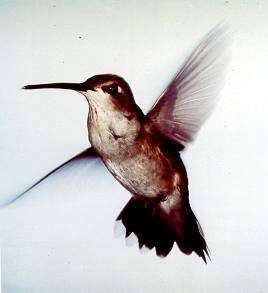 |
|
This little hen
is so heavy with eggs we can't see her feet because they have been
absorbed by her
feathers. |
 Top priority in a female hummingbird's mind for nest site
selection is: nest in a geographical area where temperatures are likely to
remain 96 degrees F or less throughout her nesting cycle.
Her reason is, she aims for an egg incubation temperature of 96 degrees. If the
temperature rises above 96 and remains above that level for several hours, (or
days) her eggs will "cook", killing the embryo. This probably explains why areas
where summer temperatures soar into the 100s see their arriving hummers
"disappear" in May. The little birds "disappeared" because they were really only
passing through on their way to cooler climate locations in our northern states
and Canada. Invariably the little rascals "reappear" in late July and early
August, and pause to show us their youngsters before humming on south to
wintering grounds in Mexico and Central America. A few Ruby-throats don't follow
the crowd and remain behind in hotter states. These birds are often found in
states with mountains high enough in altitude to experience a summer with less
harsh temperatures...the Ozark's and Appalachians, for example. (The air cools
at a rate of 5.5 degrees F per 1,000 feet rise in altitude.) However, a few
Ruby-throats remain at low altitudes in states that can sizzle in the summer.
These hardy souls have learned a unique way to escape egg cooking temperatures. Top priority in a female hummingbird's mind for nest site
selection is: nest in a geographical area where temperatures are likely to
remain 96 degrees F or less throughout her nesting cycle.
Her reason is, she aims for an egg incubation temperature of 96 degrees. If the
temperature rises above 96 and remains above that level for several hours, (or
days) her eggs will "cook", killing the embryo. This probably explains why areas
where summer temperatures soar into the 100s see their arriving hummers
"disappear" in May. The little birds "disappeared" because they were really only
passing through on their way to cooler climate locations in our northern states
and Canada. Invariably the little rascals "reappear" in late July and early
August, and pause to show us their youngsters before humming on south to
wintering grounds in Mexico and Central America. A few Ruby-throats don't follow
the crowd and remain behind in hotter states. These birds are often found in
states with mountains high enough in altitude to experience a summer with less
harsh temperatures...the Ozark's and Appalachians, for example. (The air cools
at a rate of 5.5 degrees F per 1,000 feet rise in altitude.) However, a few
Ruby-throats remain at low altitudes in states that can sizzle in the summer.
These hardy souls have learned a unique way to escape egg cooking temperatures.
 The temperature within a stand of broadleaf trees will average 5
to 7 degrees cooler than open or urban areas. This is due to the tree's
transpiration, which provides natural, evaporative air conditioning within the
tree's umbrella. (An average oak transpires 50 gallons of
water per day.) A very small population of Ruby-throats have discovered this
natural phenomena and attempt to nest at altitudes where summer temperatures
almost always exceed 100. In those cases nests are often found on the low branch
of a broadleaf tree overhanging a body of water. Female Ruby-throats have
apparently found the thin layer of cool air created by evaporation from the
water's surface. That thin layer of cool air, combined with the tree's 5 to 7
degrees worth of cooling, creates a micro environment matching northern
climates. Note that hummingbirds migrate to nesting areas where humans go to
escape summer's heat...'way north, the mountains, or a lake. The temperature within a stand of broadleaf trees will average 5
to 7 degrees cooler than open or urban areas. This is due to the tree's
transpiration, which provides natural, evaporative air conditioning within the
tree's umbrella. (An average oak transpires 50 gallons of
water per day.) A very small population of Ruby-throats have discovered this
natural phenomena and attempt to nest at altitudes where summer temperatures
almost always exceed 100. In those cases nests are often found on the low branch
of a broadleaf tree overhanging a body of water. Female Ruby-throats have
apparently found the thin layer of cool air created by evaporation from the
water's surface. That thin layer of cool air, combined with the tree's 5 to 7
degrees worth of cooling, creates a micro environment matching northern
climates. Note that hummingbirds migrate to nesting areas where humans go to
escape summer's heat...'way north, the mountains, or a lake.
 The rule for eastern states is, if you have females in June, it
is likely the birds are nesting with you. No females in June says they are
nesting elsewhere, and elsewhere is probably somewhere up
north. (In Arizona and southern California, Anna's
hummingbirds avoid egg cooking temperatures by choosing to nest in January and
February. Costa's hummingbirds avoid the desert heat by humming up to nest in
those state's mountains.) The female's second priority for nest location is:
Find a place out of the wind. The rule for eastern states is, if you have females in June, it
is likely the birds are nesting with you. No females in June says they are
nesting elsewhere, and elsewhere is probably somewhere up
north. (In Arizona and southern California, Anna's
hummingbirds avoid egg cooking temperatures by choosing to nest in January and
February. Costa's hummingbirds avoid the desert heat by humming up to nest in
those state's mountains.) The female's second priority for nest location is:
Find a place out of the wind.
 The importance of selecting a nest site that is protected from
the wind was emphasized from the experience of Jay and Carrie Hollifield of
Roswell, New Mexico. Winds catapulted ten hummingbird eggs
out of five nests from elm branches in their ranch yard in 1999. In Amistad, New
Mexico, broken hummingbird eggs were often found on the ground by Dave Dunnigan
after strong winds raked his ranch yard. 8 to 10 Black-chinned hummingbirds nest
around Dunnigan's place each year. One of his little hens was so determined to
nest out of the wind she built down low, 18 inches above the ground, on a bush
snuggled in the shelter of a hen house. It is probable this bird was not a first
year mom, but rather an experienced mom who had suffered the consequences of
high winds in a previous nesting season. This suggests hummingbirds ae capable
of learning. In May of 2000, five of Dunnigan's hummers chose to nest on
Hummingbird Houses placed under his porch eaves, out of the wind. In Roswell,
Hummingbird Houses are installed at the Hollifield place, however a dozen pairs
of cliff swallows dominate choice nesting sites under their eaves. One of those
Hummingbird Houses was even taken over by swallows. The importance of selecting a nest site that is protected from
the wind was emphasized from the experience of Jay and Carrie Hollifield of
Roswell, New Mexico. Winds catapulted ten hummingbird eggs
out of five nests from elm branches in their ranch yard in 1999. In Amistad, New
Mexico, broken hummingbird eggs were often found on the ground by Dave Dunnigan
after strong winds raked his ranch yard. 8 to 10 Black-chinned hummingbirds nest
around Dunnigan's place each year. One of his little hens was so determined to
nest out of the wind she built down low, 18 inches above the ground, on a bush
snuggled in the shelter of a hen house. It is probable this bird was not a first
year mom, but rather an experienced mom who had suffered the consequences of
high winds in a previous nesting season. This suggests hummingbirds ae capable
of learning. In May of 2000, five of Dunnigan's hummers chose to nest on
Hummingbird Houses placed under his porch eaves, out of the wind. In Roswell,
Hummingbird Houses are installed at the Hollifield place, however a dozen pairs
of cliff swallows dominate choice nesting sites under their eaves. One of those
Hummingbird Houses was even taken over by swallows.
 Nests we observed were established in places providing as much
wind protection as was available. They were sheltered either by an outer
perimeter of trees, or by buildings. Six to twelve feet
above the ground in the first row of inner branches where protection is
increased from weather elements were prevalent tree locations. Trees of choice,
in order of preference, were sycamore, fruitless mulberry, maple, elm, and
Russian olive. Note the larger the leaf, the higher the preference. Nests we observed were established in places providing as much
wind protection as was available. They were sheltered either by an outer
perimeter of trees, or by buildings. Six to twelve feet
above the ground in the first row of inner branches where protection is
increased from weather elements were prevalent tree locations. Trees of choice,
in order of preference, were sycamore, fruitless mulberry, maple, elm, and
Russian olive. Note the larger the leaf, the higher the preference.
 A fork in a branch about 18 inches from its end was a repeating
tree nest location. The chosen branch averaged 1/4" in diameter...too small to
support a cat, but dangerously whippy in high winds. A
hen's search image includes the coincidence of either a large leaf or a cluster
of leaves three inches or less directly above the fork. She utilizes this leafy
"umbrella" to protect her nest against sun and rain, and to shield her eggs and
chicks from prying predator eyes. A fork in a branch about 18 inches from its end was a repeating
tree nest location. The chosen branch averaged 1/4" in diameter...too small to
support a cat, but dangerously whippy in high winds. A
hen's search image includes the coincidence of either a large leaf or a cluster
of leaves three inches or less directly above the fork. She utilizes this leafy
"umbrella" to protect her nest against sun and rain, and to shield her eggs and
chicks from prying predator eyes.
 Nest construction
averaged five days. She brings materials to her site at a rate of 34 trips per
hour. The little hen's first load of material is spider
webbing. She applies that material as a sticky foundation on the forked area of
her nest site. Thereafter, her sequence is orderly. She airlifts plant down or
other soft material in her beak and tucks it into the fork. After shaping and
molding that material, she flies in another load of spider webbing. Most often
she carries a glob of webbing clinging to the underside of her beak, under her
throat, and down across her breast. Transfer of the webbing onto her nest is
achieved by pressing her chin and breast against the nest and wiping the webbing
onto her work. Stickiness of spider webbing appeared to be the only element
binding the nest. Frame by frame scrutiny of video tapes revealed no sign that
she used her spittle as glue. In that regard, for her little system to produce
enough spittle to construct her nest seems beyond a hummingbird's physical
capacity. Nest construction
averaged five days. She brings materials to her site at a rate of 34 trips per
hour. The little hen's first load of material is spider
webbing. She applies that material as a sticky foundation on the forked area of
her nest site. Thereafter, her sequence is orderly. She airlifts plant down or
other soft material in her beak and tucks it into the fork. After shaping and
molding that material, she flies in another load of spider webbing. Most often
she carries a glob of webbing clinging to the underside of her beak, under her
throat, and down across her breast. Transfer of the webbing onto her nest is
achieved by pressing her chin and breast against the nest and wiping the webbing
onto her work. Stickiness of spider webbing appeared to be the only element
binding the nest. Frame by frame scrutiny of video tapes revealed no sign that
she used her spittle as glue. In that regard, for her little system to produce
enough spittle to construct her nest seems beyond a hummingbird's physical
capacity.
 Bits of camouflage followed the spider webbing and were applied
to her work-in-progress. Another load of plant down was
followed by spider webbing followed by a bit of camouflage, and so on. Four
hours straight was usually her work schedule before she quit for the day. Some
of the little hens worked mornings, others were afternoon types. Since
developing eggs burdens her with extra weight throughout nest building, it made
sense that she work on the nest no more than four hours per day. Bits of camouflage followed the spider webbing and were applied
to her work-in-progress. Another load of plant down was
followed by spider webbing followed by a bit of camouflage, and so on. Four
hours straight was usually her work schedule before she quit for the day. Some
of the little hens worked mornings, others were afternoon types. Since
developing eggs burdens her with extra weight throughout nest building, it made
sense that she work on the nest no more than four hours per day.
 Concealing her work from its beginning is probably a reason the
female hummingbird camouflages her nest as she builds. One
hen was so picky about hiding her work that on the sun bleached side of a branch
she chose light colored camouflage material to match. On the shaded, and
therefore darker side of that same branch, she camouflaged that side of the nest
darker to match that side's coloration. Such attention to detail created a nest
that was camouflaged slightly differently on each side. Hummingbird House nests
were camouflaged against the color of the eave, ceiling, or patio cover where
the House was installed. Sometimes the hens gathered flakes of paint chips from
the building and applied the chips to their nest. A male bird was never seen
near a hummingbird nest. So, where is Daddy Bird during the female's flurry of
nest building activity? Concealing her work from its beginning is probably a reason the
female hummingbird camouflages her nest as she builds. One
hen was so picky about hiding her work that on the sun bleached side of a branch
she chose light colored camouflage material to match. On the shaded, and
therefore darker side of that same branch, she camouflaged that side of the nest
darker to match that side's coloration. Such attention to detail created a nest
that was camouflaged slightly differently on each side. Hummingbird House nests
were camouflaged against the color of the eave, ceiling, or patio cover where
the House was installed. Sometimes the hens gathered flakes of paint chips from
the building and applied the chips to their nest. A male bird was never seen
near a hummingbird nest. So, where is Daddy Bird during the female's flurry of
nest building activity?
 Flashy gorgets transform Daddy Birds into Mr. Neon. To protect
her children from predators, the female would be foolish to tolerate a male
spotlighting her work during nest building, or during chick
raising. In whatever ways hummingbirds communicate, after
she has been impregnated, a probable reason we don't see hummingbird males near
hummingbird nests is that she has told Daddy Bird to take his brightly colored
flashy suit and hum off. Flashy gorgets transform Daddy Birds into Mr. Neon. To protect
her children from predators, the female would be foolish to tolerate a male
spotlighting her work during nest building, or during chick
raising. In whatever ways hummingbirds communicate, after
she has been impregnated, a probable reason we don't see hummingbird males near
hummingbird nests is that she has told Daddy Bird to take his brightly colored
flashy suit and hum off.
Molding the nest's
wall as the nest progresses upward was done by pressing the top edge between her
wing and body, as a potter shapes soft clay on a spinning
vase.
|
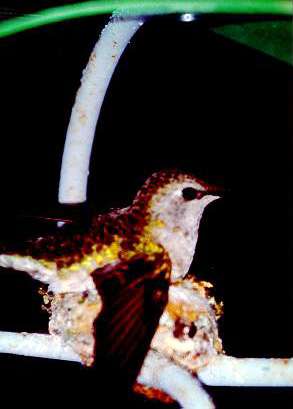 |
|
Hummingbird hen shaping her nest's edge between her wing and
body. |
 Rounding the nest's inside was done by ramming her little
bottom, with tail feathers straight up, against inner
walls. She tamps the nest's floor by hanging on with one
foot and stomping rapidly with her free foot. Since her weight is about that of
a penny, hanging on with one foot and stomping with the other to pack the nest's
floor allows her leg muscle power to compensate for her light weight. She stops
work occasionally and simply sits in her nest, as if resting. The little hens
are so focused they ignore photo equipment moved in increments to as near to
them as five feet. One photo revealed a unique pattern in the structure of
hummingbird nests, a pattern that was previously unknown. Rounding the nest's inside was done by ramming her little
bottom, with tail feathers straight up, against inner
walls. She tamps the nest's floor by hanging on with one
foot and stomping rapidly with her free foot. Since her weight is about that of
a penny, hanging on with one foot and stomping with the other to pack the nest's
floor allows her leg muscle power to compensate for her light weight. She stops
work occasionally and simply sits in her nest, as if resting. The little hens
are so focused they ignore photo equipment moved in increments to as near to
them as five feet. One photo revealed a unique pattern in the structure of
hummingbird nests, a pattern that was previously unknown.
 Backlighting a nest revealed that the lower half was thick and
dense while the upper half was thin enough to let some light
pass.
She probably incorporates this feature so that she can adjust air
circulation to maintain an egg incubation temperature of 96 degrees F, which is
5 degrees less than her normal body temperature. On cold days, she maintains egg
temperature by positioning her body below the thinner, upper half of the nests
walls hold warmth inside her nest. On hot days, raising her body above the
thinner portion of the nest's wall would increase air circulation and allow
excess egg incubation heat to escape. These smart little birds refine this
construction feature even more. Backlighting a nest revealed that the lower half was thick and
dense while the upper half was thin enough to let some light
pass.
She probably incorporates this feature so that she can adjust air
circulation to maintain an egg incubation temperature of 96 degrees F, which is
5 degrees less than her normal body temperature. On cold days, she maintains egg
temperature by positioning her body below the thinner, upper half of the nests
walls hold warmth inside her nest. On hot days, raising her body above the
thinner portion of the nest's wall would increase air circulation and allow
excess egg incubation heat to escape. These smart little birds refine this
construction feature even more.
 For additional precision of egg temperature control, the
windward side of the upper wall is thicker than its lee
side. For additional precision of egg temperature control, the
windward side of the upper wall is thicker than its lee
side.
|
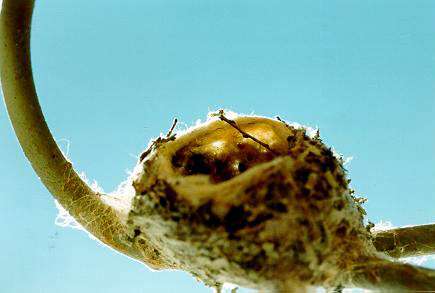 |
|
Nest with
thinner, almost "see through" upper wall on downwind side. Note side
facing camera, the side facing the prevailing wind, is
thicker. |
 The "thickest" side of the upper wall invariably faces into
prevailing wind patterns.
That suggests she fashions the windward side of her
nest to give her eggs protection against the probing fingers of a cool wind.
Further, their first nests, those constructed in the relative cool of early
spring, have thicker and therefore warmer upper walls than second nests built in
summer. Another refinement in hummingbird nest building is that their spring
nests are deeper than their summer nests. On cool days the hens snuggled down so
deep inside their nests their beaks and tail aimed straight up. On warmer days
they sat so high in the nest and were fully visible. The eggs in one nest were
"cooked" during a record heat wave that spawned eight straight days of high
temperatures ranging between 100 and 103 degrees F. Those eggs failed to hatch.
Sometimes a nest was only half finished before the hen laid her first egg. The "thickest" side of the upper wall invariably faces into
prevailing wind patterns.
That suggests she fashions the windward side of her
nest to give her eggs protection against the probing fingers of a cool wind.
Further, their first nests, those constructed in the relative cool of early
spring, have thicker and therefore warmer upper walls than second nests built in
summer. Another refinement in hummingbird nest building is that their spring
nests are deeper than their summer nests. On cool days the hens snuggled down so
deep inside their nests their beaks and tail aimed straight up. On warmer days
they sat so high in the nest and were fully visible. The eggs in one nest were
"cooked" during a record heat wave that spawned eight straight days of high
temperatures ranging between 100 and 103 degrees F. Those eggs failed to hatch.
Sometimes a nest was only half finished before the hen laid her first egg.
|
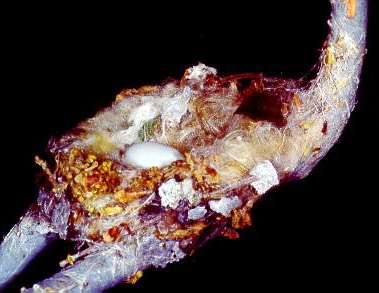 |
|
First egg
in a half finished
nest. |
 Without exception, the hens skipped one day before laying their
second egg.
In proportion to body weight, hummingbird eggs are the largest
in the bird world. If human babies were proportional to hummer eggs, we would
give birth to 25 pound babies. A long handled mechanics mirror was used to check
a nest when a hen flew off to feed. Without exception, the hens skipped one day before laying their
second egg.
In proportion to body weight, hummingbird eggs are the largest
in the bird world. If human babies were proportional to hummer eggs, we would
give birth to 25 pound babies. A long handled mechanics mirror was used to check
a nest when a hen flew off to feed.  Activity was watched from a distance through
binoculars and a telescope. Clues that a hen was "in labor" came when she
settled on her nest and alternated between wiggling and shaking a few moments.
In one case we knew within ten minutes when a hen's first egg arrived. Activity was watched from a distance through
binoculars and a telescope. Clues that a hen was "in labor" came when she
settled on her nest and alternated between wiggling and shaking a few moments.
In one case we knew within ten minutes when a hen's first egg arrived.
|
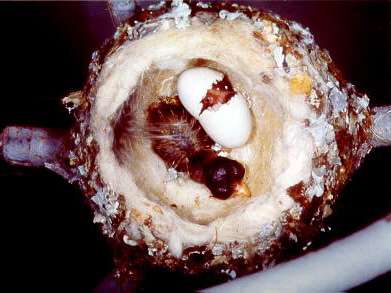 |
|
New chick
with hatching nestmate. |
 Incubation time on each nest was 14 days with one exception...a
12 day period in Texas. (That hen was smaller, and her
behavior different from other Black-chinns we observed. The hen may have been a
member of the smaller sub-species of Black-chinned Dr. Bill Baltosser believes
exists.) When the nest held eggs, it appeared the hen flew into and out of the
nest in a way that reduced the chance of downwash from her wings blasting an egg
out of her nest. In the split second during either launch or landing, she seems
to tilt her wings in a way that would direct her wing downwash away from the
nest's opening. In one nest it apeared that downwash from her hovering flight
ejected one egg, which crashed on the ground. The hen abandoned that nest and
its remaining egg. Incubation time on each nest was 14 days with one exception...a
12 day period in Texas. (That hen was smaller, and her
behavior different from other Black-chinns we observed. The hen may have been a
member of the smaller sub-species of Black-chinned Dr. Bill Baltosser believes
exists.) When the nest held eggs, it appeared the hen flew into and out of the
nest in a way that reduced the chance of downwash from her wings blasting an egg
out of her nest. In the split second during either launch or landing, she seems
to tilt her wings in a way that would direct her wing downwash away from the
nest's opening. In one nest it apeared that downwash from her hovering flight
ejected one egg, which crashed on the ground. The hen abandoned that nest and
its remaining egg.
 Chick feeding intervals averaged twenty minutes. Without
exception the moms brooded their chicks through eight
nights. The ninth they spent somewhere other than on the
nest. Chicks at that age were feathered enough to regulate their own
temperatures. The two chicks were large enough by then that their little bodies
stretched the nest and filled it side to side, with their backs almost flush
with the nest's rim. This age, nine days, is the earliest observation of
youngsters humming their wings. Chick feeding intervals averaged twenty minutes. Without
exception the moms brooded their chicks through eight
nights. The ninth they spent somewhere other than on the
nest. Chicks at that age were feathered enough to regulate their own
temperatures. The two chicks were large enough by then that their little bodies
stretched the nest and filled it side to side, with their backs almost flush
with the nest's rim. This age, nine days, is the earliest observation of
youngsters humming their wings.
 When the chicks were 21 to 22 days old, the mother hummers began
construction on a second nest while still feeding her first two nestlings.
Fledge time for the chicks was commonly 23 days, however
some where 24 or 25 days old before they left the nest. Individual chick fledge
time is probably tied to its level of nourishment. First flights were usually no
farther than the nearest branch. When the chicks were 21 to 22 days old, the mother hummers began
construction on a second nest while still feeding her first two nestlings.
Fledge time for the chicks was commonly 23 days, however
some where 24 or 25 days old before they left the nest. Individual chick fledge
time is probably tied to its level of nourishment. First flights were usually no
farther than the nearest branch.
|
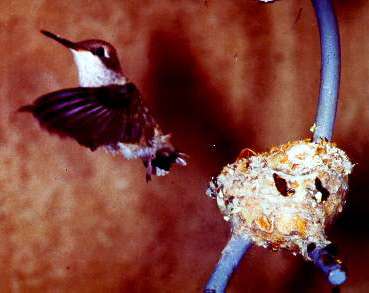 |
|
Chick
making first flight. |
 While continuing to work on their second nests, the busy mom
hummers located and fed the newly flying chicks through two to three days before
they were on their own. While building her second nest the
first egg often appeared during the time she was feeding her two fledged chicks.
The common view held by most ornithologists about hummingbirds reusing an old
nest is that they don't. We found a different answer. While continuing to work on their second nests, the busy mom
hummers located and fed the newly flying chicks through two to three days before
they were on their own. While building her second nest the
first egg often appeared during the time she was feeding her two fledged chicks.
The common view held by most ornithologists about hummingbirds reusing an old
nest is that they don't. We found a different answer.
 One tree nest was reused by a different mom hummer almost before
it had time to cool from previous use. Two Hummingbird
House nesting sites were reused by different moms within a day or two after the
first chicks fledged. Those three nests were home to a total of 12 hummingbird
chicks during one nesting season. We think these nests were reused because they
were still intact and in good condition. Few hummingbird nests survive the
winter months, and those that do are so dilapidated they are not reusable.
However, we found several cases where a new nest was built on top of an old
nest. One site had a stack of four nests, probably covering four years. One of
the little hens nested a third time. Her third set of chicks were only a month
old before they pointed their little beaks south and hummed with her and their
siblings toward wintering grounds in Mexico. One tree nest was reused by a different mom hummer almost before
it had time to cool from previous use. Two Hummingbird
House nesting sites were reused by different moms within a day or two after the
first chicks fledged. Those three nests were home to a total of 12 hummingbird
chicks during one nesting season. We think these nests were reused because they
were still intact and in good condition. Few hummingbird nests survive the
winter months, and those that do are so dilapidated they are not reusable.
However, we found several cases where a new nest was built on top of an old
nest. One site had a stack of four nests, probably covering four years. One of
the little hens nested a third time. Her third set of chicks were only a month
old before they pointed their little beaks south and hummed with her and their
siblings toward wintering grounds in Mexico.
 Some nests were exquisite, woven by hens that worked with great
skill. Others were less than perfect. Differences in
building skills likely resulted from first time nesters being less adept at nest
building than experienced moms. Some nests were exquisite, woven by hens that worked with great
skill. Others were less than perfect. Differences in
building skills likely resulted from first time nesters being less adept at nest
building than experienced moms.
 Many times one
female would hover a short distance from another female that was busy with nest
building. The busy female invariably ran the intruder away.
However, when the busy female left to gather more building material, the
intruder would zip in and either steal nesting material, or hover all around the
nest as if inspecting the work, possibly to gain building skills of her own. It
also seemed as though an intruding female was considering a take over. In one
instance, during her first day of nest building one female was building six
nests simultaneously. Each was about 20 feet apart and all were on Hummingbird
House platforms. During the second day she narrowed her building activity to
three of the six. On the third day she cut her work down to two. On the fourth
day she abandoned work on one and finished the other during her fifth day. In
two other instances one female worked on two nests simultaneously before
abandoning one and finishing the other. Many times one
female would hover a short distance from another female that was busy with nest
building. The busy female invariably ran the intruder away.
However, when the busy female left to gather more building material, the
intruder would zip in and either steal nesting material, or hover all around the
nest as if inspecting the work, possibly to gain building skills of her own. It
also seemed as though an intruding female was considering a take over. In one
instance, during her first day of nest building one female was building six
nests simultaneously. Each was about 20 feet apart and all were on Hummingbird
House platforms. During the second day she narrowed her building activity to
three of the six. On the third day she cut her work down to two. On the fourth
day she abandoned work on one and finished the other during her fifth day. In
two other instances one female worked on two nests simultaneously before
abandoning one and finishing the other.
 A roadrunner raided one New Mexico tree nest, ants killed two
day old chicks in another, and a Texas hailstorm destroyed
another. The Hummingbird House nesting sites had no weather
or predator problems. A roadrunner raided one New Mexico tree nest, ants killed two
day old chicks in another, and a Texas hailstorm destroyed
another. The Hummingbird House nesting sites had no weather
or predator problems.
 Two nests became
unattended when the mothers apparently met with unknown fates. One mom had
collected fiberglass from somewhere and used the glass for lining her
nest. Two nests became
unattended when the mothers apparently met with unknown fates. One mom had
collected fiberglass from somewhere and used the glass for lining her
nest. We suspect she may have died from an overdose of fiberglass. In our
determination to not disturb the nesting process, we waited two days after her
disappearance to intervene. Her chicks were dead. After one full day of the
other mom's absence, we placed one of her starving orphans in an active
Black-chinned nest built on a Hummingbird House, and the other orphan in an
active Magnificent nest in a tree. What must have been two surprised hummingbird
mothers, both accepted and fed the third chicks. The second day after these
transfers, the Magnificent nest was empty and that mother not seen again. It is
probable the nest was raided by a predator. Meanwhile, back at the Hummingbird
House Black-chinned nest, three growing chicks soon created a space problem. The
two largest chicks crowded the smaller chick outside the nest, where it hung by
a tiny toenail hooked to spider webbing fourteen feet above the ground. The
problem was solved by installing the orphaned chick's "old" birth nest side by
side with its new nest and putting the toe-nail-hanging chick alone back in its
original nest. The mother continued to feed all three chicks and they all
fledged. We suspect she may have died from an overdose of fiberglass. In our
determination to not disturb the nesting process, we waited two days after her
disappearance to intervene. Her chicks were dead. After one full day of the
other mom's absence, we placed one of her starving orphans in an active
Black-chinned nest built on a Hummingbird House, and the other orphan in an
active Magnificent nest in a tree. What must have been two surprised hummingbird
mothers, both accepted and fed the third chicks. The second day after these
transfers, the Magnificent nest was empty and that mother not seen again. It is
probable the nest was raided by a predator. Meanwhile, back at the Hummingbird
House Black-chinned nest, three growing chicks soon created a space problem. The
two largest chicks crowded the smaller chick outside the nest, where it hung by
a tiny toenail hooked to spider webbing fourteen feet above the ground. The
problem was solved by installing the orphaned chick's "old" birth nest side by
side with its new nest and putting the toe-nail-hanging chick alone back in its
original nest. The mother continued to feed all three chicks and they all
fledged.

 Although we learned lessons from tree
nests, we learned more from the Hummingbird House nests because they provided an
ambiance that allowed intimate observations from the nest's beginning to its end
. Although we learned lessons from tree
nests, we learned more from the Hummingbird House nests because they provided an
ambiance that allowed intimate observations from the nest's beginning to its end
.
 To see a hummingbird nest in action, check under the porch
ceiling of County Line Barbeque in Albuquerque, New Mexico, between May 1 and
August 30. Two moms nested there on Hummingbird Houses in
the summer of 2000. Since hummers tend to return and breed in the area where
they were raised, if both little hens survive the winter, they should return to
the restaurant, along with surviving daughters in 2001. It is probable that
between 3 and 6 nests will be built and occupied there in the summer of 2001.
(Three hens returned and were nesting under County Line's porch ceiling as of
May 24, 2001.) The total number of nesting hummers from year to year in the
restaurant's developing hummingbird colony will depend on how many moms and
their daughters survive the winters. Extra Houses are in place for additional
moms. In 2002, there could be 6 to 10 hummingbirds raising chicks in nests under
County Line's porch. To see a hummingbird nest in action, check under the porch
ceiling of County Line Barbeque in Albuquerque, New Mexico, between May 1 and
August 30. Two moms nested there on Hummingbird Houses in
the summer of 2000. Since hummers tend to return and breed in the area where
they were raised, if both little hens survive the winter, they should return to
the restaurant, along with surviving daughters in 2001. It is probable that
between 3 and 6 nests will be built and occupied there in the summer of 2001.
(Three hens returned and were nesting under County Line's porch ceiling as of
May 24, 2001.) The total number of nesting hummers from year to year in the
restaurant's developing hummingbird colony will depend on how many moms and
their daughters survive the winters. Extra Houses are in place for additional
moms. In 2002, there could be 6 to 10 hummingbirds raising chicks in nests under
County Line's porch.
 Hummingbird banders have established the average life-span of
female hummers to be 3 1/2 years. Average male life-span is 2 1/2. Black-chinned
record longevity is 7 years. Hummingbird banders have established the average life-span of
female hummers to be 3 1/2 years. Average male life-span is 2 1/2. Black-chinned
record longevity is 7 years.
 The
longest Black-chinned migration on record is that of a male banded at Sonita,
Arizona, in July of 1988. In April of 1991, this little guy was recovered a few
miles NNW of Manzanillo, Mexico, 930 miles south of Sonita. This was the first
documented hummingbird flight linking the US and Mexico. Here's to many
more. The
longest Black-chinned migration on record is that of a male banded at Sonita,
Arizona, in July of 1988. In April of 1991, this little guy was recovered a few
miles NNW of Manzanillo, Mexico, 930 miles south of Sonita. This was the first
documented hummingbird flight linking the US and Mexico. Here's to many
more.
Happy humming.
Dan & Diane True
Authors of "Hummingbirds of North America".
 May 24, 2001 update: Observations gained so far during
this 2001 nesting season have caused us to wonder: May 24, 2001 update: Observations gained so far during
this 2001 nesting season have caused us to wonder:
Picture this: A hen
heavy with eggs is looking for a place to build a nest. At the same time,
winds are blowing hard, gyrating tree branch nest sites so violently as to
make nest building difficult to impossible. Desperation, plus the urgency of
eggs about to arrive forces her to build on a porch light fixture, or other
device such as our Hummingbird House, neither of which is gyrating because
they are protected from the wind. Picture the same situation on a day with
steady rain. The urgency of eggs about to arrive forces her to search for a
nest site while it is raining. Trees are wet and dripping. Again, she finds a
porch light fixture, or our Hummingbird House, both of which are dry during
the rain. Being smart, she builds a nest there and successfully raises her
family.
|





 HummerDome-8 oz
HummerDome-8 oz
 Hummerfest Hummingbird Feeder-12 oz.
Hummerfest Hummingbird Feeder-12 oz.
 Hummerfest Hummingbird Feeder-8 oz.
Hummerfest Hummingbird Feeder-8 oz.
 Nectar Pot
Nectar Pot
 Window-Mount Hummingbird Feeder-16 oz.
Window-Mount Hummingbird Feeder-16 oz.
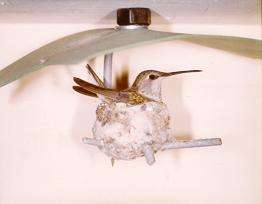 Hummingbird House
Hummingbird House

 Woodside Gardens
The Registry of Nature Habitats
Woodside Gardens
The Registry of Nature Habitats 
 1999 -
1999 -





